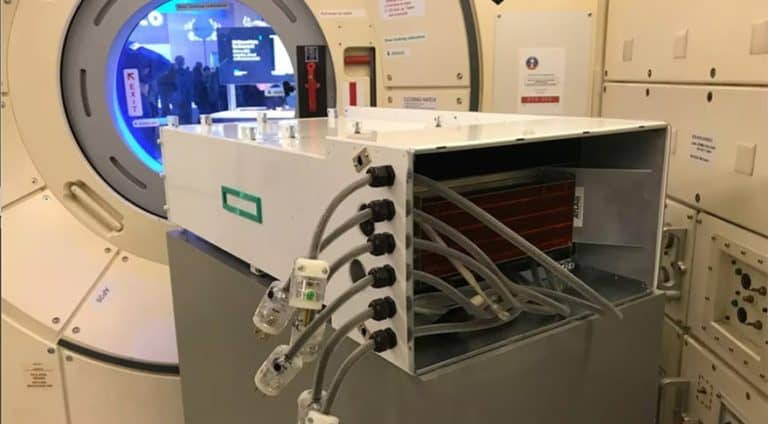HPE’s Spaceborne Computer is back on earth after a one and a half hour test on board the ISS. The manufacturer is now going to extensively analyse the device, which consists of traditional earth components, in order to assess the impact of the challenging environment on the hardware.
In 2017, HPE sent a compact supercomputer to the International Space Station ISS on board a Dragon SpaceX capsule. The Spaceborne Computer, as the manufacturer calls it, is relatively vulgar and that is what makes the hardware so unique. Space is a challenging environment for computing infrastructure. Temperatures can fluctuate, the power supply in the space station is less stable with peaks and troughs, but especially radiation is a problem. The absence of an atmosphere means that cosmic radiation mercilessly attacks the equipment and that has an impact on its operation.
Chip museum in space
This is why manufacturers usually choose to make their hardware extra robust. That process takes time and is very expensive. The result is that you can find hardware outside the atmosphere that would be particularly useful within the atmosphere in a museum. For example, the beating heart of the ISS is built with Intel 80386SX-cpus, which provides a computing power of 20 MHz. New Horizons, which gave us the first close-ups to Pluto in 2016, did so with a Mongoose-V processor: a hardened but slower version of the chip that drove the original PlayStation.
HPE wondered whether that hardware reinforcement process could not be circumvented by a smart software solution and the Spaceborne Computer is the result of that line of thought. Software on the supercomputer monitors vital parameters of the system and allows it to take autonomous action. This allows the computer to temporarily turn itself off when the voltage reaches unsafe proportions. Against other problems such as radiation, some terrestrial hardware is theoretically already armed. Just think of ECC memory, which with a system of hashes can detect and mitigate bitflips by radiation.
Extra time in space
The SpaceBorne Computer is such an HPC system with commercial components as you can find here on the ground floor in the racks. The system consists of two nodes in a quarter-rack, and runs Red Hat Enterprise Linux 6.8. The computer is a variant of HPE’s Apollo 40 servers and has a processing power of one teraFLOPS.
At launch, HPE’s plan could count on the necessary scepticism, but the computer was exemplary in carrying out its task. For the first year, the system completed all the tests without any problems. At the end of October 2018, a Russian Soyuz made an unexpected but much-needed demonstration of the capsule’s emergency abort system, which delayed all transport to and from the ISS. For example, the computer was given an extra six months on board free of charge and that period was used for new experiments. For example, the computer was already simulating the calculations that a spacecraft can make when it returns to earth through the atmosphere.
On control
HPE will now analyse the Spaceborne Computer in detail and look at the impact of space and radiation on the hardware. The manufacturer will investigate whether individual components are more worn out in their challenging environment, and if so, how much. The research is important because it makes computer power more affordable for future missions. Especially with expeditions to, for example, Mars in mind, in which transmissions with the earth are subject to a long delay, it is important that people are able to carry out as much work as possible on site. A supercomputer with the level of current copies in data centres can help.
Related: From own chips to exascale supercomputer: Europe competes with Intel and Nvidia
This news article was automatically translated from Dutch to give Techzine.eu a head start. All news articles after September 1, 2019 are written in native English and NOT translated. All our background stories are written in native English as well. For more information read our launch article.